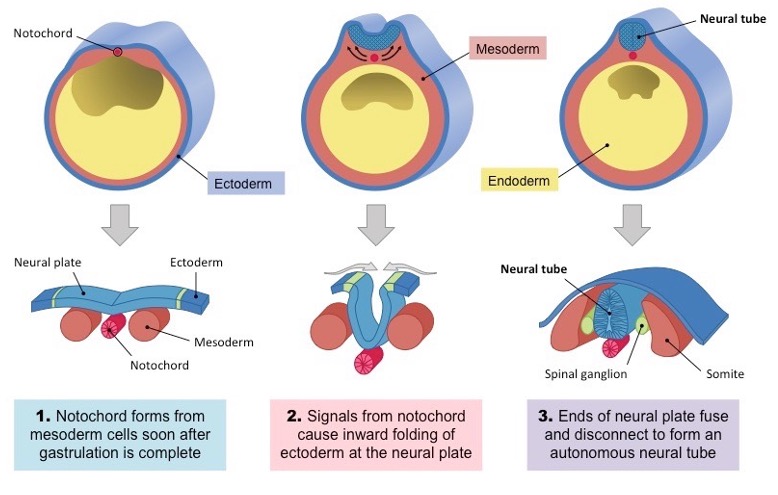Definition of Ectoderm
The word ecto means “outside,” and derma means “skin”. It is the outermost layer of cells or tissue of an embryo during early development. The other two layers are the mesoderm (middle) and endoderm (innermost). It surrounds the embryo and can develop into a variety of internal as well as external structures. There are two tissue layers present in diploblasts, the ectoderm, and endoderm, while the triploblasts contain all three layers.
Formation of Ectoderms
The ectoderm is developed during embryogenesis, specifically during gastrulation when cells start differentiating. Some of the existing cells will become ectoderm cells early in development when the embryo has already divided but hasn’t yet started to form into a new body part (gastrulation).

Gastrulation can happen in several ways in different animals. The ectoderm in amphibians is only found in the animal part of the blastula until gastrulation when it spreads to cover the whole embryo in an epiboly process.
In fish and birds, future endoderm and mesoderm cells move inside in a process called “introgression.” The cells that stay outside become future ectoderm cells, and the cells that move inside become future endoderm cells. If you look at placental mammals, things are even more different because they need extra-embryonic structures to help their embryos grow in the womb.
Before gastrulation, the fertilized egg is made up of a trophectoderm and an inner cell mass. The trophectoderm constructs extra-embryonic structures like the placenta while the inner cell mass grows into the embryo itself. The embryo then splits into primitive endoderm and ectoderm, with the embryonic ectoderm starting gastrulation on the inside of the embryo.
You may also like to read;
-
Adenosine Triphosphate (ATP): Definition, Structure, and Function
-
Bilirubin: Definition, Metabolism, and Function
Function of the Ectoderm
The ectoderm is one of the embryo’s primary cell layers. Ectoderm cells develop into other external structures like skin, sweat glands, skin receptors, and hair follicles. The ectoderm is also responsible for the formation of the cornea and lens of the eyes, the enamel of the teeth, the mouth, the rectum, and the pineal and pituitary glands.
The key role of the ectoderm is to form the central nervous system (brain and spinal cord). After gastrulation, the mesoderm forms the rod-like notochord, which communicates the adjacent dorsal ectoderm to thicken and form the neural plate. In a process known as neurulation, the neural plate folds inward to form the neural tube.
The neural tube will eventually develop into the spinal cord and brain. The neural crest is the junction between the neural tube and the dorsal ectoderm. In the later part of development, the neural crest cells will differentiate into various cell types, such as peripheral nerves and skull bones.
The neural tube formation from ectoderm is represented by neurulation in the above illustration. The transformation of the dorsal ectoderm into the epidermis and neural plate is depicted. The neural plate then forms the neural tube.
Related Questions
1. Which of the following structures is not created by ectoderm?
- A. skin dermis
- B. pituitary gland
- C. dental enamel
- D. the spinal cord
2. When do the cells differentiate into ectoderm cells?
- A. cleavage
- B. gastrulation
- C. organogenesis
- D. formation of patterns
3. What structure eventually gives rise to the central nervous system?
- A. notochord
- B. neural crest
- C. neural tube
- D. somites
References
- Campbell, N. A., & Reece, J. B. (2005).Biology, 7th. ed. Chs. 32 and 47. San Francisco, CA: Benjamin Cummings. ISBN: 0-8053-7171-0.
- Jessell, T., Lawrence, P., Meyerowitz, E., Robertson, E., & Smith, J. (2005).Principles of Development, 3rd. ed. Chs. 1 and 3. New York, NY: Oxford University Press. ISBN: 0-19-927537-8.
Answers and Explanations
Q1. A is the correct answer. The mesoderm gives rise to the dermis. At the same time, the ectoderm gives rise to external structures like the skin, the epidermis forms rather than the dermis.
Q2. B is the correct answer. Although ectoderm cells differentiate during gastrulation, their fate is determined during cleavage.
Q3. C is the correct answer. The neural tube will eventually give rise to the brain and spinal cord. The notochord signals formation of the neural tube, and the neural crest is responsible for the formation of the peripheral nervous system and other cell types.





